“Cook all the foods, hack all the things /
Make all the booze, hack all the things”
In beer brewing, the temperature profile during mashing has important implications for the beer’s eventual body and “mouthfeel”. The requirements for partial mash brewing are a bit more relaxed than all-grain, but still matter (the enzymatic reactions occur over the range of ~150-160F, but progress differently depending on the time spent in various portions of that range.) More to the point, manually babysitting this for a large pot of not-yet-beer on a stovetop is a pain in the arse, so the other night I just modded our electric range for external closed-loop temperature control.
The hack is pretty simple and should be straightforward to apply to most electric stoves. The supplies needed are a temperature controller (typically a PID controller), a temperature probe (typically thermocouple or RTD), and a beefy solid-state relay. I’d also highly recommend a jack for the control signal connection so it can be easily unplugged and stashed somewhere when not in use. In my case, I also added a beefy bypass switch that allowed the mod to be done in a reversible and failsafe way.
I am very fortunate to have a wife who puts up with my relentless tweaking around and warranty-voiding :-p She didn’t even flip a shit when she went for breakfast one morning and saw this:

Even so, a mod that involved loose ugly equipment and snarls of exposed wiring was probably not going to fly – so this had to be done with no or minimal visible changes.
Electric range guts in brief
Your parents’ (or maybe grandparents’) generation put a man on the Moon, so you might think a modern electric stove is full of microcontrollery precision and closed-loop systems targeting a specific glass temperature (non-contact IR temp sensors being about a buck fifty in quantity now). But nothing could be further from the truth. Typically, any and all temperature regulation is contained in the control knob itself, using a hacky-sounding mechanical assembly known as an infinite switch. It’s basically a bimetallic strip, like in an old thermostat, stuck on top of a variable resistor set by the knob position. The heat from the resistor makes/breaks the circuit at some interval proportional-ish to knob position, but it doesn’t know or care what kind of thermal load is on the burner. More relevant to this application, it also means there is no nice relay controlling everything, ready to have its nice low-voltage control signal hijacked with an Arduino or similar. This mod requires working directly with mains voltage and current, typically 240VAC (for North America at least), and obviously at enough amps to make things glow.
The mod
The stove I have features several burners of various sizes. I targeted the largest one for modification as this is the only one large enough for the brewpot. This burner features three independent elements that can be enabled in increments (inner, inner+middle, or all) to heat things of various sizes. Upon removing the back panel of the stove, I found a wiring diagram folded up and tucked inside behind the control knobs. This provided a good starting point, and also helpfully reported that the burner pulls 3,000W when all 3 elements are engaged, at a resistance of only 19.2 ohms across the 240V mains. Yikes!
Assuming a full 240V (RMS) from the wall, the burner should pull 12.5A (Ohm’s law). For a safety margin and (mainly) the belief that random solid state relays, usually made in China, may tend to be “optimistic” about their current ratings, I bought one rated for 40A, along with a PID temperature controller (Auber Instruments SYL1512A) and a waterproof RTD (resistance temperature detector) probe. PID control mathematically anticipates the future output for a given input, providing more accurate control (e.g. reducing overshoot), especially in an application like this with plenty of thermal inertia. The output of this controller is directly compatible with typical solid state relays, which are controlled by a DC voltage (typically accepting a wide range such as 3-24V). To avoid any possibility of overstressing the elements from rapid cycling, the controller cycle time setting was lengthened to be closer to the cycle times observed from the manual control, about 15 seconds.
A simplified diagram for the 3-element burner, before and after modification, is shown below. The dotted boxes in the top figure represent various internal switches on the control knob. Note that despite being drawn as completely independent switches, they are actually sequenced by the knob in a manner that isn’t entirely clear (and I didn’t care to reverse-engineer with a meter). I felt the most failsafe approach would be to wire the relay in series with the main switch, with a bypass switch in parallel with the relay, rather than bypass the knob switch with the relay. This provides “normal” (relay bypassed) vs. “external control” (bypass switch open) modes, and ensures that the burner can still be used normally if the relay ever fails, either open or short. The knob must still be turned to one of the ON positions to operate in either mode, so a during-the-night relay or controller failure cannot activate the burner unattended.
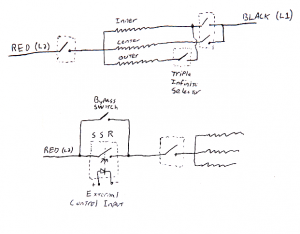
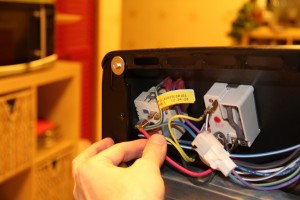
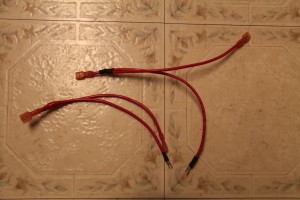
Passing 3000W is no small potatoes, so external heatsinking on the solid-state relay is needed. For this I bolted the relay to a scrap aluminum plate, drilled a few holes in the stove’s back panel and bolted it to the inside. Thermal grease on all mating surfaces aids heat transfer. The plate acts as a heat spreader, making the entire back panel one big (if not particularly efficient) heatsink. The relay was positioned to fit into a gap between the control knobs and the main electronics assembly (clock / oven control) inside the front panel.
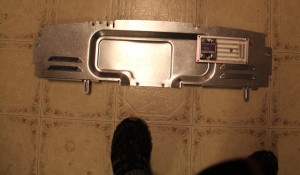
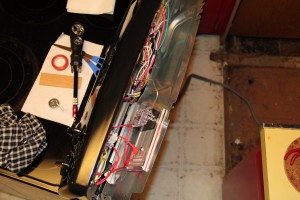
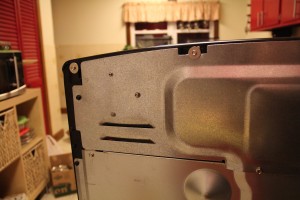
Wiring for the bypass switch and relay control input was snaked through small gaps underneath the front panel, and the switch and a phono jack for the relay control were mounted tucked underneath the front panel using J-B Weld. In the end, unless you get up close and squint just right, you probably couldn’t tell the stove didn’t come this way.
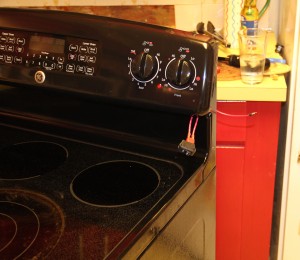
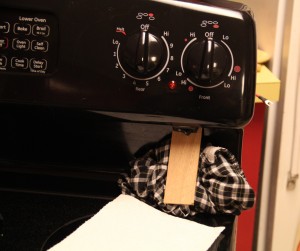
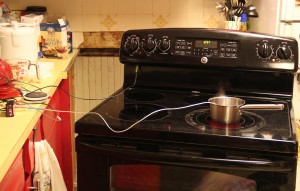

Sidenote: The hacks that didn’t get done
While I had the unit open, there was also the remote possibility of fixing a few cringeworthy design flaws, I mean “features”, in the oven portion, which IS microprocessor-controlled. One is that the temperature display actively lies to you: as soon as the oven meets or exceeds your set temperature, it will lock the displayed “actual” temperature to this value regardless of any subsequent, including major, fluctuations in the actual temperature. This is probably done to hide the poor bang-bang thermal regulation from the customer, but can be very annoying if you’re furiously fanning the door to cool it off in a hurry, or need to lower the set temperature for any reason. The other one is that you cannot – I mean you are actively forbidden to – set an oven temperature lower than 175F (a temperature where bacteria cannot thrive). Doubtless this is the work of lawyers trying to stop stupid people from cooking up Montezuma’s Revenge casseroles, but tough noogies if you wanted to dry some herbs or keep some bread warm.
As an embedded programmer by day, I figure oven firmware should be simple enough that this could be a short afternoon reverse engineering, right? Alas, the microcontroller turns out to be an obscure Renesas part with a rather obtuse-looking in-circuit programming protocol (not PIC, AVR or anything else I can easily borrow a programmer for and try to suck the firmware out). I decided I didn’t care enough to try implementing my own reader on the off chance the firmware was left unprotected.
Leave a Reply